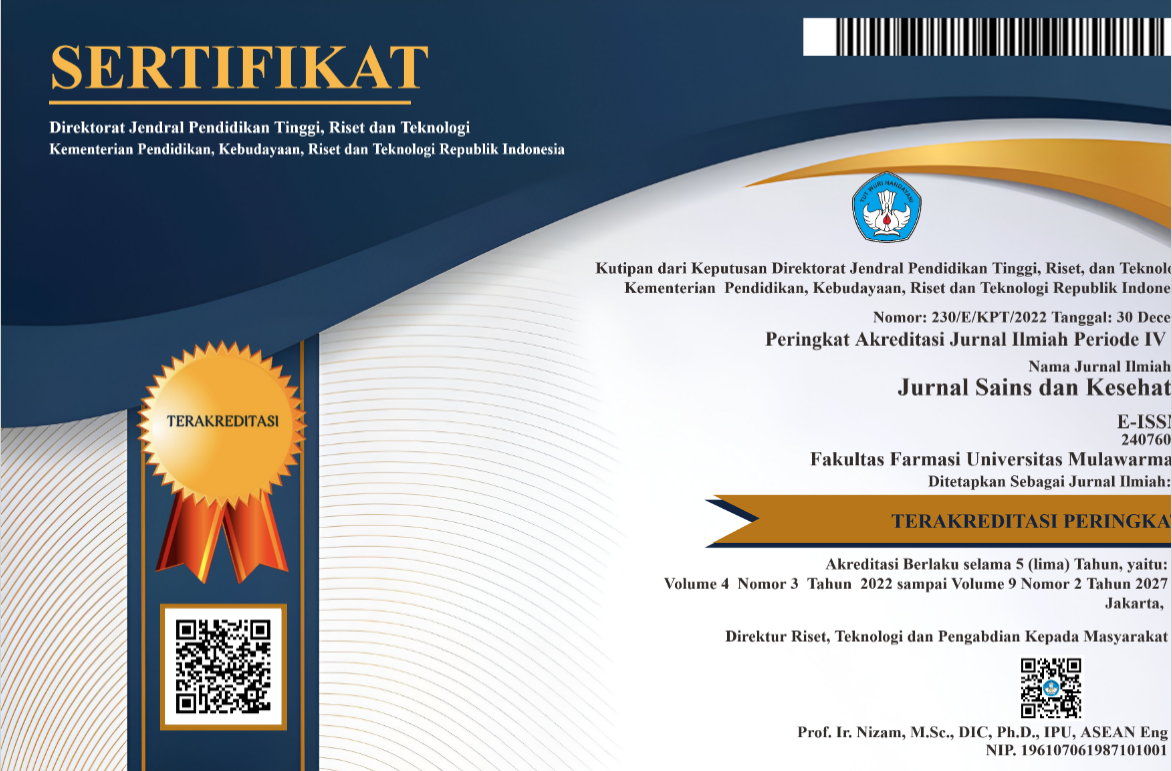Skrening Kandungan Kimia Macaranga gigantea Reichb.f. & Zoll Interaksi terhadap GSTs
Chemical Compound Screening Macaranga gigantea Reichb.f. & Zoll Interaction against GSTs
Keywords:
GSTs, Macaranga gigantean, StabilisasiAbstract
References
N. P. Vermeulen, J. G. Bessems, and R. Van de Straat, “Molecular aspects of paracetamol-induced hepatotoxicity and its mechanism-based prevention.,” Drug Metab. Rev., vol. 24, no. 3, pp. 367–407, 1992, doi: 10.3109/03602539208996298.
C. E. Presnell et al., “Computational insights into the role of glutathione in oxidative stress.,” Curr. Neurovasc. Res., vol. 10, no. 2, pp. 185–194, May 2013, doi: 10.2174/1567202611310020011.
N. A. Mazlan et al., “Antioxidant, Antityrosinase, Anticholinesterase, and Nitric Oxide Inhibition Activities of Three Malaysian Macaranga Species,” Sci. World J., vol. 2013, p. 312741, 2013, doi: 10.1155/2013/312741.
E. T. Arung et al., “Antioxidant and Antimelanogenesis Activities of Glyasperin A from Macaranga pruinosa Leaves,” Nat. Prod. Commun., vol. 14, no. 7, 2019, doi: 10.1177/1934578X19867192.
O. Korb, T. Stützle, and T. E. Exner, “Empirical scoring functions for advanced Protein-Ligand docking with PLANTS,” J. Chem. Inf. Model., vol. 49, no. 1, pp. 84–96, 2009, doi: 10.1021/ci800298z.
ChemAxon, “ChemAxon - Software Solutions and Services for Chemistry and Biology,” MarvinSketch, Version 16.10.31, 2016. https://chemaxon.com/.
D. Systèmes, “Free Download: BIOVIA Discovery Studio Visualizer - Dassault Systèmes.” 2020, [Online]. Available: https://discover.3ds.com/discovery-studio-visualizer-download#_ga=2.4935860.685747970.1587999055-a5d1c1c0-3176-11e9-a86f-e302515d21c8.
M. Tanjung, E. H. Hakim, D. Mujahidin, M. Hanafi, and Y. M. Syah, “Macagigantin, a farnesylated flavonol from Macaranga gigantea,” J. Asian Nat. Prod. Res., vol. 11, no. 11, pp. 929–932, 2009, doi: 10.1080/10286020903302315.
F. O. Akerina, T. Nurhayati, and R. Suwandi, “Isolation and Characterization of Antibacterial Compounds from Sea Urchin,” J. Pengolah. Has. Perikan. Indones., vol. 18, no. 1, 2015, doi: 10.17844/jphpi.v18i1.9564.
N. F. Mohd Rasid, N. Ahmat, and A. S. Kamarozaman, “Two flavonoids isolated from the leaves of Macaranga gigantea,” Planta Med, vol. 82, no. S 01, p. P141, 2016, doi: 10.1055/s-0036-1596305.
Y. Gu et al., “Crystal structure of human glutathione S-transferase A3-3 and mechanistic implications for its high steroid isomerase activity.,” Biochemistry, vol. 43, no. 50, pp. 15673–15679, Dec. 2004, doi: 10.1021/bi048757g.
J. Rossjohn et al., “Human theta class glutathione transferase: the crystal structure reveals a sulfate-binding pocket within a buried active site.,” Structure, vol. 6, no. 3, pp. 309–322, Mar. 1998, doi: 10.1016/s0969-2126(98)00034-3.
A. J. Oakley, M. Lo Bello, M. Nuccetelli, A. P. Mazzetti, and M. W. Parker, “The ligandin (non-substrate) binding site of human Pi class glutathione transferase is located in the electrophile binding site (H-site).,” J. Mol. Biol., vol. 291, no. 4, pp. 913–926, Aug. 1999, doi: 10.1006/jmbi.1999.3029.
K. E. Hevener et al., “Validation of molecular docking programs for virtual screening against dihydropteroate synthase,” J. Chem. Inf. Model., vol. 49, no. 2, pp. 444–460, Feb. 2009, doi: 10.1021/ci800293n.
Downloads
Published
Issue
Section
Deprecated: json_decode(): Passing null to parameter #1 ($json) of type string is deprecated in /home/jskff/public_html/plugins/generic/citations/CitationsPlugin.php on line 68
How to Cite
Similar Articles
- Muhammad Khairul Nuryanto, Swandari Paramita, Abdillah Iskandar, Sjarif Ismail, Andre Kusuma Ruslim, Aktivitas Anti-Inflamasi In Vitro Ekstrak Etanol Daun Vernonia amygdalina DELILE Dengan Pengujian Stabilisasi Membran , Jurnal Sains dan Kesehatan: Vol. 1 No. 8 (2017): J. Sains Kes.
You may also start an advanced similarity search for this article.




